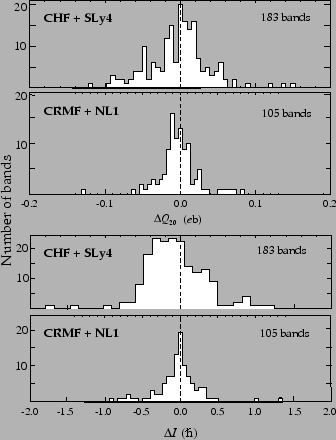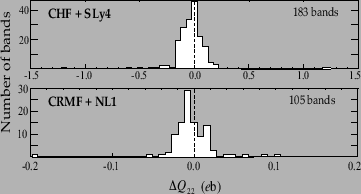One of the main outcomes of this
study is the set of effective s.p. moments
![]() ,
,
![]() ,
,
![]() , and alignments
, and alignments
![]() . The quality
of the additivity principle can be assessed by studying
the distribution of first moments of
residuals (25), i.e., differences
between the self-consistently calculated
values of physical observables and those obtained from the additivity
principle. For instance, for the quadrupole moment
. The quality
of the additivity principle can be assessed by studying
the distribution of first moments of
residuals (25), i.e., differences
between the self-consistently calculated
values of physical observables and those obtained from the additivity
principle. For instance, for the quadrupole moment ![]() , the
quantity of interest is
, the
quantity of interest is
 , and
, and
|
|
The results for the total angular momentum are shown in the bottom
panels of Fig. 5. In CRMF, the distribution of deviations
is very narrow, with only 10% of the cases differing by more than
 . The CHF histogram is somewhat wider, but more than 90%
of deviations fall within the
. The CHF histogram is somewhat wider, but more than 90%
of deviations fall within the  interval. Taking into
consideration that the experimental spins of highly deformed and SD
bands are often assigned with uncertainties that are multiples of
interval. Taking into
consideration that the experimental spins of highly deformed and SD
bands are often assigned with uncertainties that are multiples of
![]() , our results give considerable encouragement for theoretical
interpretations based on the method of relative (effective) alignments
[13,47,8].
, our results give considerable encouragement for theoretical
interpretations based on the method of relative (effective) alignments
[13,47,8].
In CHF and CRMF, the distributions of deviations of charge quadrupole
moments ![]() (Fig. 6) are relatively narrow. Again,
for CRMF, nearly 95% of deviations fall within
(Fig. 6) are relatively narrow. Again,
for CRMF, nearly 95% of deviations fall within ![]() 0.025eb, and 98%
fall within
0.025eb, and 98%
fall within ![]() 0.1eb. For CHF, the distribution of deviations is
somewhat wider, with more than 90% of deviations falling within the
0.1eb. For CHF, the distribution of deviations is
somewhat wider, with more than 90% of deviations falling within the
![]() 0.2eb interval.
0.2eb interval.
We interpret these results as a strong indication that the additivity
principle works fairly well in self-consistent cranked theories. While
distributions of deviations in ![]() and
and ![]() are rather similar
in the CHF+SLy4 and CRMF+NL1 models (see top of Fig. 5 and
Fig. 6), deviations in angular momentum differ between
these two approaches. Considering that (i) the uncertainties in
are rather similar
in the CHF+SLy4 and CRMF+NL1 models (see top of Fig. 5 and
Fig. 6), deviations in angular momentum differ between
these two approaches. Considering that (i) the uncertainties in
 are similar in both methods (Sec. 3.3), and (ii) shape polarization effects are not that
different (Sec. 3.2), one can conclude that the
observed difference is due to the polarization of time-odd mean fields.
However, the detailed investigation of this effect is beyond the scope
of this study.
are similar in both methods (Sec. 3.3), and (ii) shape polarization effects are not that
different (Sec. 3.2), one can conclude that the
observed difference is due to the polarization of time-odd mean fields.
However, the detailed investigation of this effect is beyond the scope
of this study.